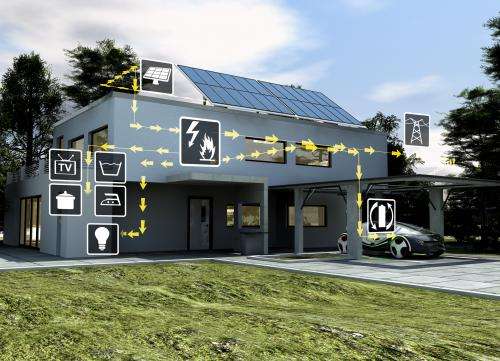Solutions for an Internet of energy

In the EU-funded Artemis research project, Siemens has developed solutions for a future "Internet of Energy." This Internet of Energy is defined as the networking of relatively autonomous electricity producers and consumers, who determine and cover the energy demand among themselves. Such an infrastructure will become necessary when large numbers of electric vehicles have to be supplied with energy in the future. Siemens has, among other things, developed technologies that integrate electric vehicles into the energy management systems of large buildings. The results are being presented at the European Conference on Nanoelectronics and Embedded Systems for Electric Mobility ecoCity eMotion in Erlangen from September 22-26.
Like other energy consumers and small producers, electric cars still operate in a completely uncoordinated manner, feeding energy into the grid at random times and tapping electricity in a similarly arbitrary manner. If their numbers continue to increase, their energy demand and the energy they can supply will have to be planned in advance in order to keep the grid stable. According to experts, the solution is to create an Internet of Energy that would largely allow consumers and producers to coordinate supply and demand autonomously among themselves. An Internet of Energy would be equipped with smart forecasting systems that would use weather forecasts, traffic expectations and other information to predict future energy demand.
Within the framework of Artemis, Siemens is developing solutions that enable large numbers of small producers to coordinate power generation more or less on their own while maintaining grid stability. The grid is connected to the Internet through secure, seamless interfaces so that the electric vehicles' energy needs can be coordinated with the supply. In the development of this system, the electric vehicles also serve as a model for other decentralized energy consumers and suppliers. Basically, the aim is to combine the infrastructure - and therefore also the power grid - with the Internet in order to fully control the flow of energy. The necessary information is provided by a range of different systems, including power flow sensors that will be installed at a large number of points throughout the distribution network, even on its medium-voltage lines. Siemens is also developing highly efficient power electronics for charging stations and other systems. In combination with fast energy storage devices, these electronics will ensure optimum grid stability.
During the conference, Siemens is demonstrating its latest developments for the Internet of Energy at its research facility. It is showing how various smart charging stations for alternating and direct current can be integrated into the energy management system of a large functional building. The system regulates and controls the flows of energy and loads within the building. In addition, simulations show how the energy manager can incorporate the current traffic situation - in this case information about the electric vehicles - into its forecasts.
Provided by Siemens





















